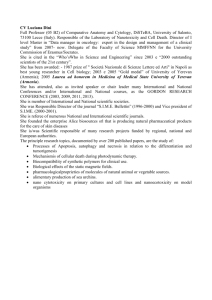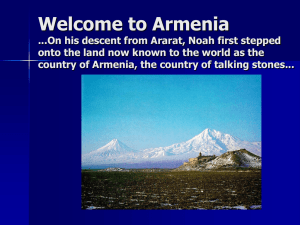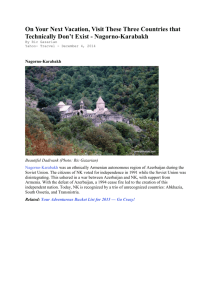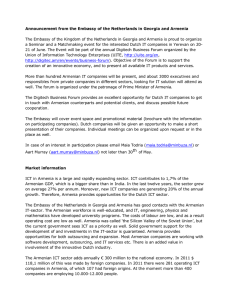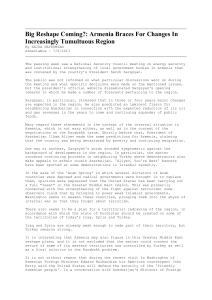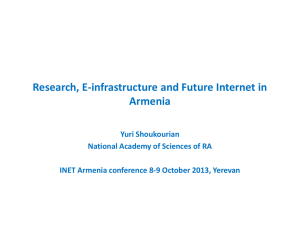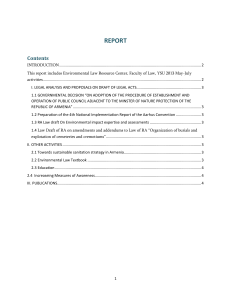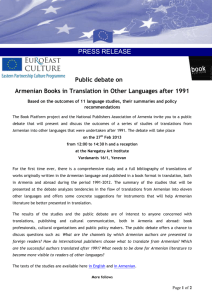OFFICIAL NAME: Republic of Armenia CAPITAL
advertisement
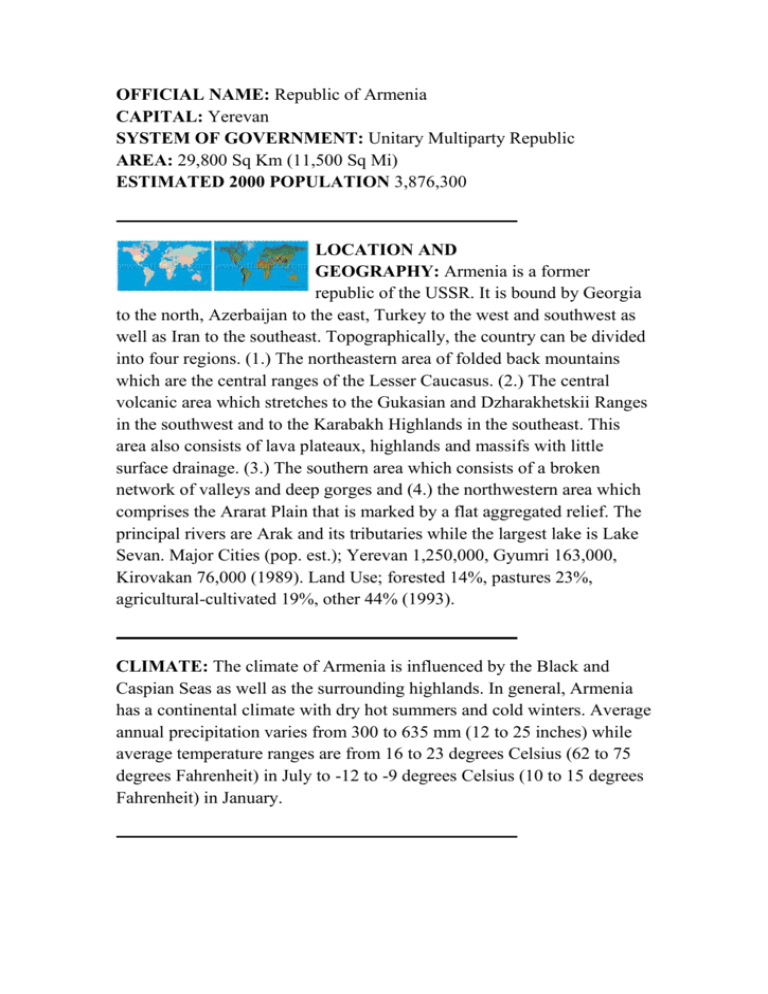
OFFICIAL NAME: Republic of Armenia CAPITAL: Yerevan SYSTEM OF GOVERNMENT: Unitary Multiparty Republic AREA: 29,800 Sq Km (11,500 Sq Mi) ESTIMATED 2000 POPULATION 3,876,300 LOCATION AND GEOGRAPHY: Armenia is a former republic of the USSR. It is bound by Georgia to the north, Azerbaijan to the east, Turkey to the west and southwest as well as Iran to the southeast. Topographically, the country can be divided into four regions. (1.) The northeastern area of folded back mountains which are the central ranges of the Lesser Caucasus. (2.) The central volcanic area which stretches to the Gukasian and Dzharakhetskii Ranges in the southwest and to the Karabakh Highlands in the southeast. This area also consists of lava plateaux, highlands and massifs with little surface drainage. (3.) The southern area which consists of a broken network of valleys and deep gorges and (4.) the northwestern area which comprises the Ararat Plain that is marked by a flat aggregated relief. The principal rivers are Arak and its tributaries while the largest lake is Lake Sevan. Major Cities (pop. est.); Yerevan 1,250,000, Gyumri 163,000, Kirovakan 76,000 (1989). Land Use; forested 14%, pastures 23%, agricultural-cultivated 19%, other 44% (1993). CLIMATE: The climate of Armenia is influenced by the Black and Caspian Seas as well as the surrounding highlands. In general, Armenia has a continental climate with dry hot summers and cold winters. Average annual precipitation varies from 300 to 635 mm (12 to 25 inches) while average temperature ranges are from 16 to 23 degrees Celsius (62 to 75 degrees Fahrenheit) in July to -12 to -9 degrees Celsius (10 to 15 degrees Fahrenheit) in January. PEOPLE: The principal ethnic majority are Armenians who account for 93% of the population while around 3% are Azerbaijanis. Other ethnic minorities include Ukrainians and Russians. DEMOGRAPHIC/VITAL STATISTICS: Density; 119 persons per sq km (309 persons per sq mi) (1993). Urban-Rural; 69.5% urban, 30.5% rural (1991). Sex Distribution; 49.5% male, 50.5% female (1992). Life Expectancy at Birth; 67.4 years male, 73.3 years female (1990). Age Breakdown; 30% under 15, 26% 15 to 29, 21% 30 to 44, 14% 45 to 59, 6% 60 to 64, 3% 65 and over (1990). Birth Rate; 21.6 per 1,000 (1992). Death Rate; 6.5 per 1,000 (1992). Increase Rate; 15.1 per 1,000 (1992). Infant Mortality Rate; 17.9 per 1,000 live births (1990). RELIGIONS: Mostly Christians of the Armenian Orthodox, Roman Catholic and Evangelical Churches. LANGUAGES: The official language is Armenian while Russian is also widely spoken and each ethnic minority also has its own language. EDUCATION: Aged 25 or over and having attained: primary or no formal schooling 7.4%, incomplete secondary 18.6%, complete secondary 57.7%, higher 13.8% (1989). Literacy; N/A. MODERN HISTORY - WWII TO 1993: On Dec. 12, 1991 Armenia declared its independence, although prior to independence its history was closely tied with that of the former Union of Soviet Socialist Republics (USSR). In Mar. 1953 Yosef Stalin died and was succeeded by Georgy Malenkov who was in turn forced to relinquish the party leadership to Nikita Khrushchev after a little over one week in power. In 1955 the Warsaw pact militarily aligned the Soviet Union with other communist countries and in Nov. 1956 the Soviet Red Army invaded Hungary to quell uprisings. In 1957 three communist ministers unsuccessfully attempted to depose Khrushchev which resulted in their expulsion from the central committee. In 1962 under Khrushchev's rule the USSR was involved in the Cuban Missile crisis and in the same year relations with China were broken off as a result of ideological differences. In Oct. 1964 Khrushchev was forced to retire and was succeeded by Leonid Brezhnev. In Aug. 1968 the Warsaw Pact forces led by the Red Army invaded Czechoslovakia to halt their Prague Spring reforms. In 1977 Breshnev was elected President. In Nov. 1982 Brezhnev died and was succeeded by Yuri Andropov, the former head of the KGB. Andropov introduced limited economic reforms and established an anti-corruption program. In Feb 1984 Andropov died and was succeeded by Konstantin Chernenko who in turn died on Mar. 10, 1985. On Mar. 11, 1985 Mikhail Gorbachev was elected as Chernenko's successor and Gorbachev embarked on a program which restructured the USSR's relations with the West. Gorbachev also established Glasnost (openness) as well as Perestroika (restructuring and reform). In Apr. 1986 a meltdown in the reactor of the Chernobyl nuclear power station in Ukraine sent radioactive fallout across northern Europe. In Dec. 1987 the USSR and USA signed the Treaty on Intermediate Nuclear Forces (INF). In Feb. 1988 a dispute erupted between Armenia and Azerbaijan over the enclave of NagornoKarabakh which resulted in mass demonstrations and strikes in the two republics. In Dec. 1988 an earthquake in Armenia killed some 50,000 people. In Apr. 1989 troops violently repressed demonstrations in Tbilisi, the capital of Georgia. In Dec. 1989 the Lithuanian Parliament adopted multiparty politics. In Jan. 1990 Gorbachev visited Lithuania and was met by some 250,000 pro-independence demonstrators. In Feb. 1990 some 18 people were killed in riots over housing discrimination in Tajikistan. In May 1990 Boris Yeltsin was elected President of the Russian Federation and on Nov. 1, 1990 launched a 500 day plan to give the Russian Republic a free market economy. In June 1990 Nakhichevan an Azerbaijani enclave bordering Iran declared its intention for a unification with Iran while a civil war was escalating between Azerbaijan and Armenia. In the same month around 150 people were killed during ethnic clashes in Kyrgyzstan. In Jan 1991 another 15 people were killed as the Red Army seized a television station in Lithuania while in Latvia the Soviet Black Berets killed 5 people in an attack on the ministry building. In the same month troops were being deployed in Ukraine, Georgia, Armenia and Moldova. In Mar. 1991 pro-Yeltsin demonstrators held a mass rally. On Aug. 18, 1991 as Gorbachev was vacationing in the Crimea, the Politburo hard liners attempted a coup to remove Gorbachev from power through the declaration of a State of Emergency under the control of a State Committee. Almost immediately republic leaders declared the emergency committee illegal as well as unconstitutional and began to barricade their parliaments as troops and tanks were deployed throughout the republics. By Aug. 20 senior officers had refused to order their troops to use force against the civilians and on Aug. 21, 1991 the coup collapsed as troops were ordered to return to their barracks. Immediately following the unsuccessful coup many republics suspended or purged the communist party and on Sept. 5, 1991 after 3 days of debate the 74 years of centralized communist control came to an end. In Jan. 1992 Armenia became a founding member of the Commonwealth of Independent States (CIS). Since the break-up of the USSR, fighting between Armenia and Azerbaijan has escalated over the disputed enclave, Nagorno-Karabakh, that has been territory of Azerbaijan since 1923 although the population is predominately Armenian. In Feb. 1992 the Armenian forces captured Khojali providing them with access to the only airfield in the region. This allowed the Armenian forces to ferry in supplies to continue the war and to gain air control thus halting the indiscriminate bombing of Armenian towns and villages there. After taking the enclave a land corridor through Azerbaijani territory was secured linking Armenia to Nagorno-Karabakh. The enclave declared its independence as the Republic of Nagorno-Karabakh and requested Armenian recognition. Pres. Levon Ter-Petrosyan refused to recognize the republic arguing that Armenia shouldn't be the first to do so. The Nargorno-Karabakh parliament disagreed with Ter-Petrosyan who was prepared to accept autonomy and free access for the enclave. The conflict with Azerbaijan was bringing economic hardship for Armenia as it had been cut of from its energy resources which forced a slowdown in manufacturing with industrial capacity running at only 18% in October 1992 while the state bank had no foreign reserves and money due from the collapse of the USSR was frozen in the Bank for Foreign Trade in Moscow. During 1993 Armenia was relatively politically stable despite the severe economic hardships and the waning support for Pres. TerPetrosyan. In Feb. 1993, Prime Minister Khosrow Arutyunyan was dismissed after a disagreement on the 1993 budget. In July 1993 economic relations with Russia were further strained when the Russian Central Bank decided to withdraw from circulation all pre-1993 banknotes. In Sept. 1993 an opposition standoff and demand for new parliamentary elections to be held in March 1994 was rejected. On Nov. 22, 1993 Armenia officially introduced a new national currency the Dram. Also during 1993 little progress had been made regarding a satisfactory political settlement over the war and disputed enclave of Nagorno-Karabakh. Foreign relations with Iran, Turkey and Russia deteriorated after Karabakh Armenian forces launch fresh summer offensive in southern Azerbaijan. The offensive was thought to be Yeravan inspired and resulted in Armenia's further political isolation. CURRENCY: The official currency is the Dram (D) formerly the Rouble (R) divided into 100 Lumas. ECONOMY: Gross National Product; USD $2,462,000,000 (1993). Public Debt; N/A. Imports; R 290,477,000,000 (1993). Exports; R 155,666,000,000 (1993). Tourism Receipts; N/A. Balance of Trade; R 1,039,000,000 (1990). Economically Active Population; 1,592,000 or 42.4% of total population (1994). Unemployed; 5.6% (1994). MAIN TRADING PARTNERS: Its main trading partner is the CIS. MAIN PRIMARY PRODUCTS: Antimony, Arsenic, Barley, Chromites, Citrus Fruits, Copper, Cotton, Gold, Iron, Limestone, Livestock, Magnesium, Mercury, Molybdenum, Potatoes, Pumice, Silver, Sugar Beets, Tobacco, Wheat, Wine Grapes, Zinc. MAJOR INDUSTRIES: Automobiles, Cement, Ceramics, Chemical and Petrochemical Processing, Electronics, Food Processing, Glass, Machinery and Machine Tools, Construction Materials, Sugar Refining, Textiles, Timber Processing. MAIN EXPORTS: Automobiles, Ceramics, Chemicals, Electronics, Glass, Machine Tools, Machinery, Petrochemicals, Processed Foods, Textiles, Timber. TRANSPORT: Railroads; route length 823 km (511 mi) (1991), passenger-km 316,000,000 (196,000,000 passenger-mi) (1990), cargo ton-km 4,884,000,000 (3,345,000,000 short ton-mi) (1990). Roads; length 7,700 km (4,785 mi) (1991). Vehicles; cars 230,110 (1990). Merchant Marine; nil. Air Transport; passenger-km 5,556,900,000 (3,452,897,000 passenger-mi) (1993), cargo ton-km 49,000,000 (33,560,000 short ton-mi) (1993). COMMUNICATIONS: Daily Newspapers; total of 7 with a total circulation of 82,000 (1992). Radio; receivers 642,000 (1993). Television; receivers 722,000 (1993). Telephones; units 584,000 (1993). MILITARY: est. 32,700 (1994) total active duty personnel with 100% army while military expenditure accounts for 2.3% of the Gross National Product (GNP).
